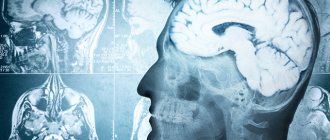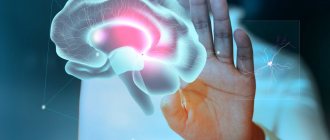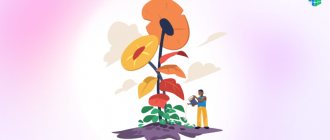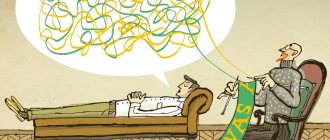Good day, dear reader! Today we will discuss a unique creation of nature - the human brain, more precisely its right hemisphere, and the exercises that you will find in this article will help develop and activate its functions. Now I’ll explain why I wanted to focus on this topic. Firstly, it is responsible for creative abilities, and its development will help reveal the potential inherent in us. Secondly, the education and upbringing system has long been aimed only at the left hemisphere, which has led to an imbalance in our thinking. Therefore, it is necessary to harmonize the work of the entire brain.
If you are an analyst and a pure logician (this means that you have a leading left hemisphere) and feel that you lack creativity and creativity, do not rush to get upset. There are methods and exercises that will help turn on the sleeping right hemisphere. I will describe these methods in detail at the end of the article, but for now let’s look at the role played by the right hemisphere.
- Intuition
- Imagination
- Orientation in space
- Processing nonverbal information
- Holistic Perception
- Understanding metaphors and humor
- Musicality
- Drawing
- Emotions
- Dreams
Thanks to the right hemisphere, we can holistically perceive people’s faces, emotions, and distinguish voice intonations. Metaphors and anecdotes are not perceived in a literal sense, but their hidden meaning becomes clear, associations and imagination are used. In addition, the right hemisphere controls the left side of the body.
Agree, these are important functions that are developed to a greater or lesser extent in all people. Now imagine what opportunities can open up if you make your brain work even more productively. Intuition will become sharper, empathy and sensitivity will develop, hidden abilities and talents will be revealed.
What is the left hemisphere of the brain responsible for?
The left hemisphere is mainly responsible for analysis and logic. One hemisphere will always work more actively than the other.
The left hemisphere is responsible for:
- logical thinking;
- understanding only the literal meaning of words;
- reading and writing abilities;
- number and symbol recognition;
- language abilities;
- speech control;
- solving mathematical problems;
- analysis of all facts;
- processing information sequentially, in stages.
Art therapy and dementia
Ellen Stewart suggests using art therapy to identify developing dementia. Thus, in group art therapy sessions, dementia can manifest itself in a person’s passivity and inability to start drawing without outside help. Some people with Alzheimer's may draw very small, inexpressive, drawing only in one corner of the sheet.
The most important feature of art therapy is the use of symbols. Typically, symbol formation requires summarizing a person's experience in a simple form. The symbol becomes a polysemantic concept in our head, while its full meaning is not realized, because it is not at the level of language, but at the level of sensations.
This is especially important for people with dementia. The language system is one of the first to be disrupted in such patients. It becomes very difficult for them to express themselves, their thoughts and emotions. Art therapy does not address the verbal areas of the brain, it works through images and symbols, through sensory, thereby allowing such people to communicate with the world around them.
Since during art therapy we actively stimulate the visual areas of our brain, and they, according to scientists, have a significant impact on episodic memory, this approach helps people with dementia maintain their memory and remember what is happening around them.
Unfortunately, dementia is an age-related disease. The fact that older people begin to load their brains less with external events and are more likely to withdraw into themselves contributes to the emergence of psychological and physiological problems in them. Art therapy is an opportunity to expand your horizons, to try something new at a time when you have time for it - in old age. After all, in fact, old age is the very period when plans can be realized, and nothing except physical capabilities will distract from this. Want to write a book? It's time!
The nature of the left hemisphere
Left-hemisphere people are often emphatically rational and reasonable. They write a lot and willingly, they easily remember long texts, and their speech is correct. They are characterized by a heightened sense of duty, responsibility, integrity, and the internal nature of processing emotions. They often occupy administrative positions, but they lack flexibility, spontaneity and spontaneity in expressing feelings. They prefer to act according to pre-drawn up schemes and stencils, and have difficulty rebuilding their relationships.
How to develop the left hemisphere of the brain
Since the main specificity of the left hemisphere is logical thinking, generalization and analysis, exercises aimed at its formation will include all kinds of logical tasks.
Neurogymnastics. Train your brain with your body. Neurogymnastics includes warming up for the hands and fingers. It has a beneficial effect on memory and attention and helps coordinate the work of the brain, synchronizing the activity of both halves.
Habitual actions with an unusual hand. Try, for example, brushing your teeth or using a smartphone with your non-working hand (left if you are right-handed, and vice versa). This engages the right brain, helping to develop lateral thinking.
Mind cards. A graphic structured display of key information differs from a simple outline in that in the process of creating it, the brain uses two hemispheres at once - the left one is responsible for the logical structure of the mind map.
Logic problems. Studying Euler's theory of sets and circles helps you think consistently and logically, as well as make informed decisions.
Verbal counting. Mathematical calculations, carried out without the help of additional devices and devices, also contribute to the development of the left hemisphere of the brain.
The Neuroscience of Art Therapy
Where is art therapy hidden among these complex scientific researches? As Kathy A. Malchiodi, an American art therapist and mental health consultant, said, “Art therapy is body-mind communication.” Through art therapy, we constantly target sensory areas, engaging the amygdala and hippocampus, while avoiding activity in the verbal areas of the brain. Practicing art results in the brain constantly stimulating itself.
Scientist Vija Lusebrink explains the effect of art therapy by the large-scale involvement in the activity of various areas of the brain. Movement involves our motor memory, sometimes bypassing areas of the brain that, for one reason or another, are not working correctly.
If the direct connection between the anterior and posterior cortex of the brain is disrupted due to psychological or physical trauma, then an indirect connection, through ancient brain structures, can replace it.
Among other things, art therapy has the opportunity to use a variety of materials: texture, color, shape, those that can be configured differently in space. All this activates the corresponding areas of the brain, providing an even stronger stimulating effect.
The fact that in art therapy each element affects a more or less specific set of brain areas allows it to be used for brain diagnostics. Patients with disorders in specific areas of the brain will experience characteristic changes in the pattern. For example, with lesions in the left hemisphere, a person will not be able to depict complex shapes, while in the right hemisphere, he will draw schematically.
Source
How to develop the right hemisphere of the brain
The goal is to achieve harmonious functioning of both hemispheres of the brain. Exercises to improve the functioning of the right hemisphere of the brain help suppress the dominance of the left, but they should not inhibit logical and sequential thinking too much.
The simplest exercises for developing the right hemisphere of the brain:
- if imagination and creative thinking are insufficient, visiting art galleries, museums and other creative events is recommended;
- the development of the right hemisphere of the brain stimulates drawing (there is also a “mirror” image technique, when the drawing is reproduced simultaneously with both hands), writing various stories or poems;
- To develop the right hemisphere, a right-handed person can perform everyday activities using mainly the left half of the body (this exercise is not suitable for a left-handed person).
How to determine which hemisphere is dominant
— The right hemisphere is the creative hemisphere. It's melodic, it's intuitive and it's emotional. And the left hemisphere is logic; it is very important that it is the speech hemisphere. Emotionally, this is a more positive hemisphere. Determining which hemisphere is dominant is quite simple - clasp your hands and see which finger is on top - your right hand or your left. If it is left, then your right hemisphere is dominant, but if the finger of your right hand is on top, then the left hemisphere is dominant. It always crosses paths,” says neuropsychologist Svetlana Shishkova in the program “Association of Practical Psychologists and Coaches.”
Which hemisphere of your brain is dominant can also be determined using a test. We invite you to watch the video carefully. If the figure rotates clockwise, your left hemisphere is dominant. Rotating counterclockwise means your right hemisphere is dominant. If the figure rotates alternately in one direction or the other, this is a sign of equivalent work of both the right and left hemispheres of the brain.
Try it yourself
Art therapy is most often used by trained psychotherapists who understand exactly how and what exercise is best to use for a particular case. However, you can use some techniques yourself: to understand yourself, to have fun, to somehow improve cognitive abilities by activating the brain, to reduce the level of mental fatigue. We offer five exercises that are used in art therapy. You can do them yourself. The main thing is that there is a calm environment around you and nothing distracts you from the art.
- Mandala Creation - This exercise asks you to create a complex figure from a series of symmetrical symbolic patterns. First, you create a mandala frame (several concentric circles), divide all the circles into two equal parts, use a protractor to select points on the circles at equal distances, and draw radial lines through them from the center. Then the actual drawing begins - fill the resulting sectors one by one with any element. You do this from the inner circle to the outer. Having filled the space from the center to the first circle, outline the contours of the picture and begin filling the next sector.
Source
- Color Therapy - Each color has unique physical characteristics. This means that brain activity also differs when perceiving different colors. Thanks to this, painting with different colors allows you to stimulate your brain in a comprehensive way. So, Leah Guzman suggests drawing a circle and dividing it into eight parts. In each section, identify different emotions and color each one with a specific color. In the exercise, it is important to note which feeling came to mind first, which one is felt at the current moment in time, whether the feelings were painted in the same colors, which emotions were more positive or negative. Another, more complex version of color therapy was proposed by Tamotsu Sakaki. His goal was to help express emotions among the reserved Japanese. In this practice, you choose a color and make a blot on a piece of paper. Then you cover the blot with another sheet of white paper, which creates an image, like a Rorschach test. After that, you describe the blot using a story and give it a name. As a rule, the psychotherapist then finds a connection between the drawing, history and the patient’s problem, and can offer his own alternative interpretation.
Source
- Doodle Drawing - Since the vast majority of people are not confident in their artistic abilities, this procedure helps to draw simply for pleasure and self-expression. You can take any complex painting or photograph. It is important to look at it carefully, find key images in it, and name the picture. Children in groups can continue to play the game - guess by the title what is depicted in the painting, or choose the desired one from the presented paintings.
Next is the creative moment itself: with the help of scribbles, you try to depict the key aspect of the example picture. You can draw with your non-dominant hand, your fingers, even your toes, with your eyes closed, and use prints. Any method that is convenient and interesting to you is suitable. It turns out to be your personal abstract painting, for which you can come up with a new name.
You can do the exercise differently: draw an arbitrary curve on a piece of paper and ask another person to complete it, to create a complete drawing. Then you can start explaining: what is being painted, why the colors are those, do you like the painting, what mood does it evoke, etc.
Source
Those people who are good at scribbling can try to reach a higher level of skill.
Source
- Filling out a body template - you can find a template with a picture of a human body and depict a certain feeling in it. For example, fear. This allows you to relieve tension, distance yourself from the emotion, and better control it due to the fact that the artist sees its visual manifestation.
- Bilateral therapy - this method was developed by Dr. K. McNamee, who offered participants a piece of paper divided into two halves (for each hemisphere of the brain). You draw traumatic emotions or experiences into these halves. On one half, you should draw negative experiences with the hand that is more strongly associated with the emotional experience. On your other half, with the other hand, you draw the opposite, positive experience. Due to this, according to the author, bilateral emotional stimulation of the brain is achieved.
There are many exercises used in art therapy. Some of them may require you to obtain a master's degree in this topic. But most can be used independently, with loved ones and with children. You will find even more exercises on the English-language YouTube channel ehowhealth.
Art therapy is a great way to physically influence our mental state: reduce fatigue, improve cognitive abilities, get rid of depression and other disorders.
This is a wonderful tool that can be used for children's developmental learning. After all, if you think about it, all our successes at school began with drawings, scribbles, colors and fantasies. And then they sent a letter and an invoice. Most of us then simply forgot about our artistic talents and did not find time for dance or a musical instrument. But it’s time to remember that the creative activity that is activated during art therapy stimulates our brain, keeping it in good shape. It makes our life more exciting and allows us to express what cannot be expressed in language.









